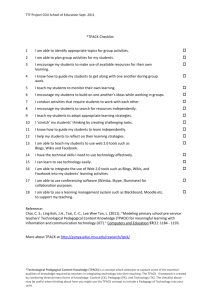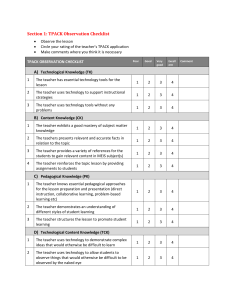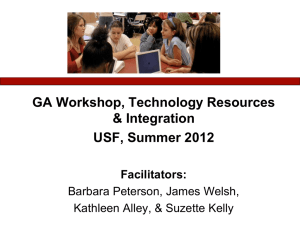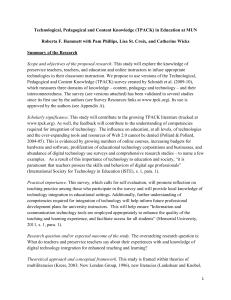Integrating Technology into Pre
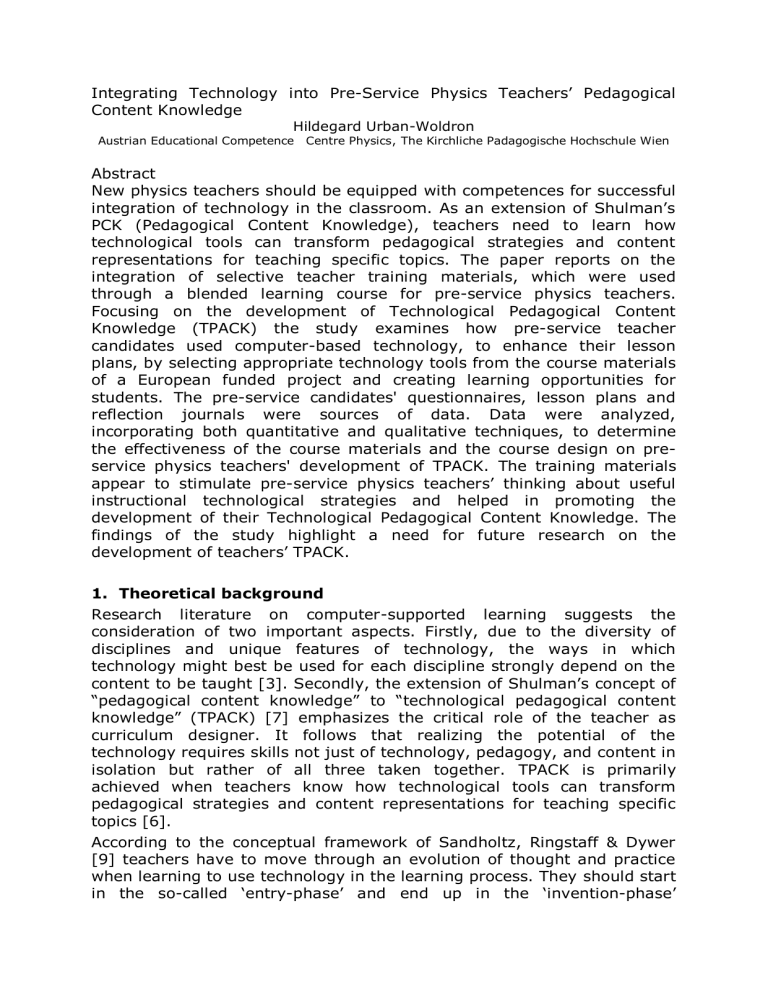
Integrating Technology into Pre-Service Physics Teachers‟ Pedagogical
Content Knowledge
Hildegard Urban-Woldron
Austrian Educational Competence Centre Physics, The Kirchliche Padagogische Hochschule Wien
Abstract
New physics teachers should be equipped with competences for successful integration of technology in the classroom. As an extension of Shulman‟s
PCK (Pedagogical Content Knowledge), teachers need to learn how technological tools can transform pedagogical strategies and content representations for teaching specific topics. The paper reports on the integration of selective teacher training materials, which were used through a blended learning course for pre-service physics teachers.
Focusing on the development of Technological Pedagogical Content
Knowledge (TPACK) the study examines how pre-service teacher candidates used computer-based technology, to enhance their lesson plans, by selecting appropriate technology tools from the course materials of a European funded project and creating learning opportunities for students. The pre-service candidates' questionnaires, lesson plans and reflection journals were sources of data. Data were analyzed, incorporating both quantitative and qualitative techniques, to determine the effectiveness of the course materials and the course design on preservice physics teachers' development of TPACK. The training materials appear to stimulate pre-service physics teachers‟ thinking about useful instructional technological strategies and helped in promoting the development of their Technological Pedagogical Content Knowledge. The findings of the study highlight a need for future research on the development of teachers‟ TPACK.
1.
Theoretical background
Research literature on computer-supported learning suggests the consideration of two important aspects. Firstly, due to the diversity of disciplines and unique features of technology, the ways in which technology might best be used for each discipline strongly depend on the content to be taught [3]. Secondly, the extension of Shulman‟s concept of
“pedagogical content knowledge” to “technological pedagogical content knowledge” (TPACK) [7] emphasizes the critical role of the teacher as curriculum designer. It follows that realizing the potential of the technology requires skills not just of technology, pedagogy, and content in isolation but rather of all three taken together. TPACK is primarily achieved when teachers know how technological tools can transform pedagogical strategies and content representations for teaching specific topics [6].
According to the conceptual framework of Sandholtz, Ringstaff & Dywer
[9] teachers have to move through an evolution of thought and practice when learning to use technology in the learning process. They should start in the so-called „entry-phase‟ and end up in the „invention-phase‟
discovering new uses for technology tools and using technology as a flexible tool in the classroom to facilitate the emergence of new teaching and learning practices. At a typical entry-level, the teacher uses direct instruction and whole class activities to deliver content and skills to the students. In a classroom of a teacher at innovation (or invention)-level, students are engaged in using technology to do things that could not be done without it.
Researchers and practitioners have been seeking reliable and valid ways to measure the constructs associated with the TPACK framework. Harris and her colleagues [4] promote in amendment of published self-report surveys for assessing TPACK an instrument that supports a performancebased evaluation of TPACK, enabling a triangulation of self-report data and external assessments. Their “TPACK-based technology integration assessment rubric” should support teacher educators to more accurately assess the quality of technology integration in their students‟ lesson plans by reflecting on four dimensions: Curriculum-based technology use, using technology in teaching/learning, compatibility with curriculum goals & instructional strategies, fit of content, pedagogy and technology together.
2.
Rationale
Recent reviews of the effects of ICT in science lessons show that teachers do not yet exploit the creative potential of ICT and do not engage students enough in the production of knowledge [1]. Therefore teachers need training and continuing professional development in the use of ICT to carefully integrate ICT into the teaching process and to provide appropriate guidance [5]. Actually, ICT-rich environments already provide a range of affordances to enable learning of science [11]. Researchers suggest that integrating these affordances with other pedagogical innovations provides even greater potential for enhancement of student learning [2]. Therefore, supporting the professional development of preservice teachers for technology integration seems to be an important issue for teacher education.
The context of this study was a teacher education course, aiming at helping prospective teachers to develop abilities to integrate technology with content and pedagogy. Teaching materials developed within a
European project and adapted for the education method course, covered three different physics topics: “Cooling & change of state”, “basic electricity concepts” and “motion & forces”. For each topic, up to three types of activities, exploiting the use of ICT to stimulate thinking and promote understanding of basic physics concepts, were offered: Datalogging, simulation and modelling.
The purpose of the study was to investigate prospective teachers‟ development of TPACK attempting to address two broad questions:
1.
Is there a relationship between the perceptions of the learning environment, motivational orientations and the self-reported evolution of TPACK?
2.
Are self-reported knowledge gains in TPACK in agreement with external assessment of teachers‟ own lesson plan designs?
3.
Method
3.1
Participants and Setting
The participants of the study included 17 prospective teachers (9 female,
8 male); all were novices in the field of technology integration in physics teaching and learning. The course was designed as blended-learning course lasting 16 weeks throughout a whole semester. For communication and collaboration as well as for the distribution of the training materials and the questionnaires an electronic platform, based on the software
Moodle, was used. There were three 4-hour in-class units in the weeks 1,
6 and 10, during which the prospective teachers were offered opportunities to learn from and not about teaching with technology. By means of self-study materials, prospective teachers had to work on individual assignments, designing lesson plans for each of the three topics, and deliver them to the instructor. The elearning-part of the course enabled prospective teachers to share and discuss their ideas.
3.2
Data Sources
The scales and items for assessing prospective teachers‟ motivational orientations and their perceptions in TPACK domains were primarily drawn from literature [8; 10] and accordingly adapted. A motivation questionnaire was administered in week 1, whereas a TPACK questionnaire was completed twice, as initial one and at the end of the semester. Additionally each of the participants of the study prepared a reflective journal on the overall process of the course at the end of the semester as well as three lesson plans at specified dates.
3.3
Data Analysis
Responses from the TPACK questionnaire were analyzed as matched-pair means for each survey question. The quality of technology integration was assessed by means of the rubric from Harris and her colleagues [4]. Also, the relationship among motivational orientations, perceived TPACK and pre-post-difference as well as the quality of TPACK inferred from the lesson plans was analyzed. As the primary method of data examination for the reflective journals and the open questions verbal inductive analysis was used. Accordingly, the data were assigned to four categories, resulting in a numerical overview of the outcomes. All items of the questionnaires were aligned on a Likert scale, ranging from 1, “I totally disagree“ to 4, “I totally agree“.
4.
Results
The findings of the study indicated that prospective teachers value the course materials as well as the design of the course to be helpful for developing a critical understanding of TPACK, independently from gender and motivational orientations. Prospective teachers‟ goals and value beliefs for the course seem to have a positive impact on the evolution of
TPACK, both inferred from self-reports and the external assessment of the
associated lesson plans. A cluster analysis (see Tab. 1) of the motivational scales shows that the participants of the study can be arranged to three groups: 29% (CL1) report high value for goal orientation, content task value and self efficacy. Whereas 47% of the students in CL 3 are confident in their abilities for accomplishing and performing the future tasks, they are not so highly intrinsically motivated and convinced about the importance and usefulness of the course. 24% of the students in CL2 can be described as students with motivational strategies clearly underneath the mean.
M
CL1
SD
CL1
M
CL2
SD
CL2
M
CL3
SD
CL3
Intrinsic goal orientation
Self efficacy for learning and
3.25
3.18
0,53
0.09
2.00
1.38
0.88
0.00
2.16
3.13
0.82
0.93
Number of students
3.43
5
0.17 1.50
4
0.00 2.27
8
0.94
Table 1. Descriptive statistics of motivational strategies
As illustrated in Fig. 1, there is a relationship between motivational orientations and evolution of TPACK. The gray bars in Fig. 1 correspond to the pre-post-differences of perceived TPACK; the white bars represent the quality of technology integration derived from the lesson plans. The values illustrate the level reached in percentages of the maximum, related to four on the used Likert scales. For example, students in CL1 valued their TPACK increase to 73% of the maximum and the quality of their lesson plans were rated to reach 67% of the maximum.
Fig. 1: Evolution of
TPACK
5.
Conclusions and Implications
In conclusion, this study provided empirical evidence about the impact of the training materials and the course design on prospective teachers‟
TPACK in particular topics of physics subject matter. However, there is a clear need for future research on how to best design teacher education programs in preparing future educators for the challenge of teaching in st century. the 21
6.
Bibliography
[1] Balanskat, A., Blamire, R., Kefala, St. (2006). The ICT Impact Report.
European Schoolnet, 2006.
[2] Bryan, J. (2006). Technology for physics instruction. Contemporary Issues in
Technology and Teacher Education, 6 (2), 230-245.
[3] Bull, G., Park, J., Searson, M., Thompson A., Mishra, P., Koehler, M.J., and
Knezek, G (2007). Editorial: Developing technology policies for effective classroom practice. Contemporary Issues in Technology and Teacher
Education, 7 (3), 129-139.
[4] Harris, J., Grandgenett, N. & Hofer, M. (2010). Testing a TPACK-Based
Technology Integration Assessment Rubric. In D. Gibson & B. Dodge (Eds.),
Proceedings of Society for Information Technology & Teacher Education
International Conference, 3833-3840.
[5] Hogarth, S., Bennett, J., Lubben, F., Campell, B., Robinson, A. (2006). ICT in science teaching. Technical report. In: Research Evidence in Education
Library: EPPI-Centre, Social Science Research Unit, Institute of Education,
University of London.
[6] Jang, S.-J., Chen, K-Ch. (2010). From PCK to TPACK: Developing a
Transformative Model for Pre-Service Science Teachers. Journal of Science
Education and Technology, 19, 553-564.
[7] Mishra, P. & Koehler, M.J. (2006). Technological pedagogical content knowledge: A new framework for teacher knowledge. Teacher College
Record , 108(6), 1017-1054.
[8] Pintrich, P.R., Smith, D.A.F., Garcia, T. & McKeachie, W.J. (1992). A Manual for the Use of the Motivated Strategies for Learning Questionnaire (MSLQ).
Washington, DC: Office of Educational Research and Improvement.
[9] Sandholtz, J. H., Ringstaff, C., & Dwyer, D. C. (1997). Teaching with technology: Creating student-centered classrooms. New York: Teachers
College Press.
[10] Schmidt, D.A., Baran, E., Thompson, A.D., Mishra, P., Kohler, M.J. & Shin,
T.S. (2009). Technological Pedagogical Content Knowledge: The
Development and Validation of an Assessment Instrument for Preservice
Teachers. JRTE, 42(2), 123-149.
[11] Webb, M.E. (2005). Affordances of ICT in science learning: implications for an integrated pedagogy. International Journal of Science Education, 27 (6),
705-735.
